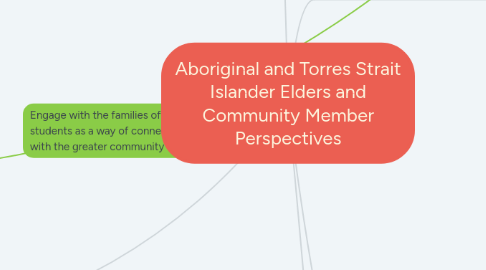
1. Embedding Perspectives
1.1. Acknowledgment of the effects of European colinisation of Australian
1.1.1. Stolen generation
1.1.2. Assimilation efforts
1.1.3. Integration efforts
1.1.4. Reconciliation efforts
1.2. Integrate the localised and accumulated knowledge of Country into the school environment
1.2.1. Story telling, reflective learning
1.2.2. Land links - links to flora and fauna
1.2.3. Non-verbal/ kinesthetic learning
1.2.4. link to local geography and culturally significant landmarks
1.3. Acknowledgement of Country
1.4. Incorporate Aboriginal and Torres Straight Islander history and culture into the classroom and school environment
1.4.1. Language
1.4.2. Yarning
1.4.3. Song/dance
1.4.4. 60,000 years of history
2. Students and Families
2.1. Some students and families may have been disconnected to their history and culture
2.2. Introduce yourself and engage with the family members of students
2.2.1. Organise to meet with parents and family members
2.3. Be open minded and listen to the thoughts, concerns and perspectives of the students and family members
2.3.1. Two way communication
2.3.2. Actions speak louder than words
2.3.3. Listen to students and parents like they have something to teach you, because they do!
2.3.4. Do not be arrogant
2.4. Offer support to students and parents
2.4.1. Research and network with local support groups
2.4.2. Research and engage with community
2.4.3. Connect students and parents with community and support groups
2.4.4. Encourage parents to join the ASSPA program
3. Education Practices
3.1. Link curriculum to the Aboriginal and Torres Strait Islander ways of knowing and being
3.1.1. knowledge grounded in sacred sites and stories
3.1.2. Interrelationship between people, animals and Country
3.1.3. 8 ways pedagogy
3.2. Do not treat Aborigninal and Torres Straight Islander culture as an add on to the curriculum
3.3. Acknowlegment of Country
3.4. Create a open and inclusive learning space for students
3.5. Do not simply exclude or suspend students
3.5.1. Reduce non-attendance rates
3.5.2. Encourage participation
4. Teachers
4.1. Understand how students learn and diversify teaching strategies
4.1.1. Experiential/kinesthetic Learning
4.1.2. Hands on
4.1.3. Watch and then do
4.1.4. Story telling
4.1.5. Non-linear
4.1.6. Collaborative and cooperative learning
4.2. Seek to understand Aboriginal and Torres Strait Islander's culture and perspectives
4.2.1. Engage with local community, parents, councilors, organisations etc.
4.2.2. Research
4.2.3. Respect protocols
4.3. Build a trusting and respectful relationship with the students and parents
4.3.1. Get involved with student extra-curricular activities
4.3.2. Build a relationship with the community and show interest in their culture
4.4. Create an open an inclusive classroom
4.4.1. Students are not scared to express themselves
4.4.2. Encourage diverse thought
4.4.3. Student collaboration
4.4.4. Respect culturally different attitudes, social norms and ways of living
5. Community Connections
5.1. Build relationships with the Community
5.1.1. learn the Connection
5.1.2. listen to the agendas of the Community
5.1.3. Students and Families
5.2. Respect protocols, values and ethical processes in connecting to community
5.2.1. i.e. men's and women's business
5.2.2. Sorry business
5.2.3. Walkabout

